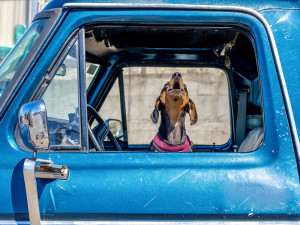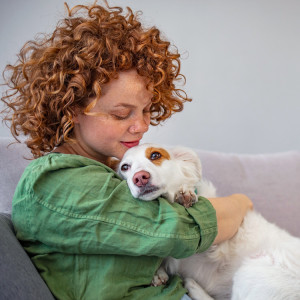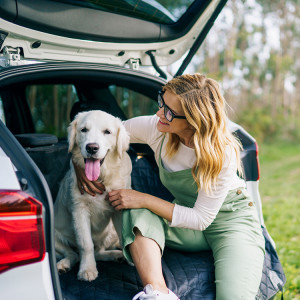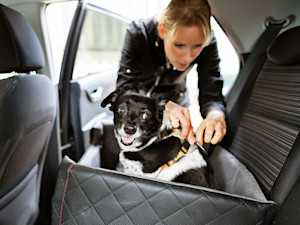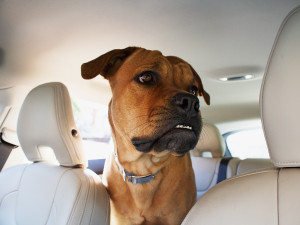Why Do Dogs Get Car Sick?
Car sickness isn’t just a human problem – it’s also common in dogs. But what causes it, and how can we help them feel better?
If you’ve ever planned a road trip with your dog only to have them start drooling, whining or even vomiting in the backseat, you’re not alone. I’ve been on trips with my dog which involved pulling over halfway to clean up a very unpleasant mess. Had he eaten something he shouldn’t have? Probably. Or, was he just a bit car sick? Also, very possible.
Many pet parents experience the frustration of car sickness in their dogs. But why does this happen, and how can we prevent it? With the help of expert vet Dr Kate McCrossan, we take a look at the main reasons behind motion sickness in dogs, and what you can do to help your four-legged friend have a more comfortable ride.
Causes of car sickness in dogs
Sensory overload
We get motion sicknessopens in new tab when there’s a conflict between what our eyes see and what our inner ear senses. “Considering dogs rely heavily on their senses to understand their environment, they go into overdrive when travelling,” says Dr McCrossan.
“Think about it: the car is full of unfamiliar smells, the landscape outside is whizzing by at an unusual speed, and the motion of the vehicle is inconsistent. All of these factors can combine to overwhelm a dog’s sensory system.”
For dogs prone to sensory overload, a car ride can feel like being trapped in a rollercoaster with all the lights flashing and unfamiliar sounds blaring. This kind of sensory bombardment can easily (and understandably) lead to nausea.
Inner ear development
One of the most common reasons for car sickness in dogs is an underdeveloped inner ear. It’s one of the reasons why motion sickness is more common in younger dogs than in adults. “The inner ear is responsible for balance, and in young dogs, this system isn’t fully matured,” says Dr McCrossan.
Just like human children who are more likely to experience motion sickness than adults, puppies often have trouble managing the movement of a car. The good news, however, is that puppies will often outgrow travel sickness by the time they are around one year old.
Anxiety and stress
For some dogs, the mere sight of the car can be enough to trigger symptoms of car sickness. This is often due to anxiety or stress associated with car rides. “Maybe your dog associates the car with negative experiences, such as trips to the vet or a previous instance of feeling nauseous in the car. These negative associations can create a cycle: the more anxious they get, the more likely they are to feel ill,” says Dr McCrossan.
It’s important to consider your dog’s emotional state when travelling. If they’re shaking or panting even before the car starts moving, anxiety could be a major factor in their sickness.
Physical condition
“While anxiety and inner ear development are common for all dogs, sometimes there’s a physical health issue behind a dog’s motion sickness,” says Dr McCrossan. “Ear infections, vestibular disease or gastrointestinal problems can all make your dog more prone to car sickness.”
If your dog has never had an issue with car rides before but suddenly starts showing symptoms, it’s a good idea to consult your vet. They can rule out any underlying conditions and ensure that your dog’s discomfort isn’t part of a bigger health issue.
Are some breeds more predisposed to motion sickness?
While any dog can experience motion sickness, scientists analysing Wisdom Panel DNA results opens in new tab discovered that genetics play a role too. Though it’s hard to pinpoint exactly which dogs carry this gene, a DNA test opens in new tab can help you understand and manage your dog’s likelihood of developing motion sickness.
In related research, Auto Traderopens in new tab claim that certain breeds are more prone to travel sickness. Boxers topped the list, followed closely by Border Terriers and Border Collies. Other breeds like Bulldogs, Dachshunds, Pugs and Beagles were also commonly affected. However, even if your dog isn’t on this list, genetics could still be a factor.
“We aren’t entirely sure why some breeds are more susceptible than others. It could be due to a boxer or pug’s brachycephalic facial structure or certain breeds may be more reactive to heat in the car which can cause sickness. Or some dogs are genetically more anxious than others,” says Dr McCrossan.
Symptoms to watch out for
How can you tell if your dog is suffering from car sickness? Here are some common signs to look out for, according to Dr McCrossan:
Vomiting: the most obvious and unfortunate symptom. Some dogs vomit early in the ride, while others might hold out until after arriving at the destination.
Excessive drooling: one of the earliest signs, this often happens before any nausea or vomiting.
Whining or crying: vocalising can indicate discomfort or anxiety.
Pacing: dogs might seem restless or unable to settle during the car ride.
Licking lips: this can be a subtle sign of nausea.
Yawning: frequent yawning might mean your dog is trying to alleviate feelings of stress or motion sickness.
Lethargy: your normally energetic dog might appear tired or uninterested during and after a car ride.
Pay attention to these signs, you may be able to intervene early to avoid vomiting and to ease your dog’s discomfort.
Prevention and management tips
Thankfully, there are ways you can help prevent or manage car sickness in dogs. So, you can take them on holiday and enjoy trips away with all your family members. Here are some top tips:
Gradual desensitisation
“If your dog’s car sickness is linked to anxiety or negative associations, you can help by gradually getting them used to the car,” says Dr McCrossan. “Start by allowing them to sit in the stationary car for a few minutes, then reward them with a treat or toy. Gradually work up to short drives around the block, slowly increasing the duration as they become more comfortable. Over time, this desensitisation can help alleviate their fear and reduce symptoms of motion sickness.”
Create a comfortable environment
A calm and secure environment can make a big difference. Ensure your dog feels safe during the ride by using a crate or a special car harness. This will limit their movement and help prevent them from feeling disoriented. Additionally, make sure your dog has access to plenty of fresh air – cracking a window can help reduce nausea by keeping the air circulating.
Avoid feeding before travel
“If your dog tends to vomit during car rides, try to avoid feeding them a large meal right before hitting the road. An empty stomach will reduce the chances of vomiting, though you don’t want them to be too hungry either,” says Dr McCrossan. Feeding them a small meal a few hours before travel may help strike the right balance.
Calming aids
There are a variety of calming aids available to help ease your dog’s anxiety during car rides. You could try calming treats, pheromone sprays or even playing calming music designed specifically for dogs. “Some pet parents also find success with natural supplements which can help soothe the stomach,” says Dr McCrossan. “If your dog’s motion sickness is severe, your vet may recommend medication to help manage their symptoms.”
Just like humans, some dogs experience travel sickness while others enjoy the ride. Whether you’re taking your furry friend on holiday, to the groomers or anywhere else, car rides are inevitable. That’s why it’s important to address car sickness and help your dog feel more comfortable on the road.
Enjoy 30% off select Wisdom Panel™ kits using code TW30% on wisdompanel.comopens in new tab




